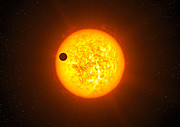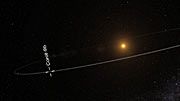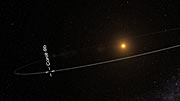Press Release
First Temperate Exoplanet Sized Up
17 March 2010
Combining observations from the CoRoT satellite and the ESO HARPS instrument, astronomers have discovered the first “normal” exoplanet that can be studied in great detail. Designated Corot-9b, the planet regularly passes in front of a star similar to the Sun located 1500 light-years away from Earth towards the constellation of Serpens (the Snake).
“This is a normal, temperate exoplanet just like dozens we already know, but this is the first whose properties we can study in depth,” says Claire Moutou, who is part of the international team of 60 astronomers that made the discovery. “It is bound to become a Rosetta stone in exoplanet research.”
“Corot-9b is the first exoplanet that really does resemble planets in our solar system,” adds lead author Hans Deeg. “It has the size of Jupiter and an orbit similar to that of Mercury.”
“Like our own giant planets, Jupiter and Saturn, the planet is mostly made of hydrogen and helium,” says team member Tristan Guillot, “and it may contain up to 20 Earth masses of other elements, including water and rock at high temperatures and pressures.”
Corot-9b passes in front of its host star every 95 days, as seen from Earth [1]. This “transit” lasts for about 8 hours, and provides astronomers with much additional information on the planet. This is fortunate as the gas giant shares many features with the majority of exoplanets discovered so far [2].
“Our analysis has provided more information on Corot-9b than for other exoplanets of the same type,” says co-author Didier Queloz. “It may open up a new field of research to understand the atmospheres of moderate- and low-temperature planets, and in particular a completely new window in our understanding of low-temperature chemistry.”
More than 400 exoplanets have been discovered so far, 70 of them through the transit method. Corot-9b is special in that its distance from its host star is about ten times larger than that of any planet previously discovered by this method. And unlike all such exoplanets, the planet has a temperate climate. The temperature of its gaseous surface is expected to be between 160 degrees and minus twenty degrees Celsius, with minimal variations between day and night. The exact value depends on the possible presence of a layer of highly reflective clouds.
The CoRoT satellite, operated by the French space agency CNES [3], identified the planet after 145 days of observations during the summer of 2008. Observations with the very successful ESO exoplanet hunter — the HARPS instrument attached to the 3.6-metre ESO telescope at La Silla in Chile — allowed the astronomers to measure its mass, confirming that Corot-9b is indeed an exoplanet, with a mass about 80% the mass of Jupiter.
This finding is being published in this week’s edition of the journal Nature.
Notes
[1] A planetary transit occurs when a celestial body passes in front of its host star and blocks some of the star’s light. This type of eclipse causes changes in the apparent brightness of the star and enables the planet’s diameter to be measured. Combined with radial velocity measurements made by the HARPS spectrograph, it is also possible to deduce the mass and, hence, the density of the planet. It is this combination that allows astronomers to study this object in great detail. The fact that it is transiting — but nevertheless not so close to its star to be a “hot Jupiter” — is what makes this object uniquely well suited for further studies.
[2] Temperate gas giants are, so far, the largest known group of exoplanets discovered.
[3] The CoRoT (Convection, Rotation and Transits) space telescope was constructed by CNES, with contributions from Austria, Germany, Spain, Belgium, Brazil and the European Space Agency (ESA). It was specifically designed to detect transiting exoplanets and carry out seismological studies of stars. Its results are supplemented by observations with several ground-based telescopes, among them the IAC-80 (Teide Observatory), the Canada France Hawaii Telescope (Hawaii), the Isaac Newton Telescope (Roque de los Muchachos Observatory), Wise Observatory (Israel), the Faulkes North Telescope of the Las Cumbres Observatory Global Telescope Network (Hawaii) and the ESO 3.6-metre telescope (Chile).
More information
This research was presented in a paper published this week in Nature (“A transiting giant planet with a temperature between 250 K and 430 K”), by H. J. Deeg et al.
The team is composed of H.J. Deeg, B. Tingley, J.M. Almenara, and M. Rabus (Instituto de Astrofısica de Canarias, Tenerife, Spain), C. Moutou, P. Barge, A. S. Bonomo, M. Deleuil, J.-C. Gazzano, L. Jorda, and A. Llebaria (Laboratoire d'Astrophysique de Marseille, Université de Provence, CNRS, OAMP, France), A. Erikson, Sz. Csizmadia, J. Cabrera, P. Kabath, H. Rauer (Institute of Planetary Research, German Aerospace Center, Berlin, Germany), H. Bruntt, M. Auvergne, A. Baglin, D. Rouan, and J. Schneider (Observatoire de Paris-Meudon, France), S. Aigrain and F. Pont (University of Exeter, UK), R. Alonso, C. Lovis, M. Mayor, F. Pepe, D. Queloz, and S. Udry (Observatoire de l'Université de Genève, Switzerland), M. Barbieri (Università di Padova, Italia), W. Benz (Universität Bern, Switzerland), P. Bordé, A. Léger, M. Ollivier, and B. Samuel (Institut d’Astrophysique Spatiale, Université Paris XI, Orsay, France), F. Bouchy and G. Hébrard (IAP, Paris, France), L. Carone and M. Pätzold (Rheinisches Institut für Umweltforschung an der Universität zu Köln, Germany), S. Carpano, M. Fridlund, P. Gondoin, and R. den Hartog (ESTEC/ESA, Noordwijk, The Netherlands), D. Ciardi (NASA Exoplanet Science Institute/Caltech, USA), R. Dvorak (University of Vienna, Austria), S. Ferraz-Mello (Universidade de São Paulo, Brasil), D. Gandolfi, E. Guenther, A. Hatzes, G. Wuchterl, B. Stecklum (Thüringer Landessternwarte, Tautenburg, Germany), M. Gillon (University of Liège, Belgium), T. Guillot and M. Havel (Observatoire de la Côte d’ Azur, Nice, France), M. Hidas, T. Lister, and R. Street (Las Cumbres Observatory Global Telescope Network, Santa Barbara, USA), H. Lammer and J. Weingrill (Space Research Institute, Austrian Academy of Science), and T. Mazeh and A. Shporer (Tel Aviv University, Israel).
ESO, the European Southern Observatory, is the foremost intergovernmental astronomy organisation in Europe and the world’s most productive astronomical observatory. It is supported by 14 countries: Austria, Belgium, Czechia, Denmark, France, Finland, Germany, Italy, the Netherlands, Portugal, Spain, Sweden, Switzerland and the United Kingdom. ESO carries out an ambitious programme focused on the design, construction and operation of powerful ground-based observing facilities enabling astronomers to make important scientific discoveries. ESO also plays a leading role in promoting and organising cooperation in astronomical research. ESO operates three unique world-class observing sites in Chile: La Silla, Paranal and Chajnantor. At Paranal, ESO operates the Very Large Telescope, the world’s most advanced visible-light astronomical observatory and VISTA, the world’s largest survey telescope. ESO is the European partner of a revolutionary astronomical telescope ALMA, the largest astronomical project in existence. ESO is currently planning a 42-metre European Extremely Large optical/near-infrared Telescope, the E-ELT, which will become “the world’s biggest eye on the sky”.
Links
- Research paper
- More info: exoplanet media kit
Contacts
Didier Queloz
Geneva Observatory, University of Geneva
Geneva, Switzerland
Tel: +41 22 379 2477
Email: didier.queloz@unige.ch
Hans J. Deeg
Instituto de Astrofísica de Canarias
Tenerife, Spain
Tel: +34 922 605 244
Cell: +34 619 360 054
Email: hdeeg@iac.es
Claire Moutou
Laboratoire d'Astrophysique de Marseille
Marseille, France
Tel: +33 4 91 05 59 66
Email: claire.moutou@oamp.fr
Henri Boffin
ESO La Silla-Paranal/E-ELT Press Officer
Garching, Germany
Tel: +49 89 3200 6222
Cell: +49 174 515 43 24
Email: hboffin@eso.org
About the Release
| Release No.: | eso1011 |
| Name: | Corot-9b |
| Type: | Milky Way : Planet |
| Facility: | ESO 3.6-metre telescope, Very Large Telescope |
| Instruments: | HARPS, UVES |
| Science data: | 2010Natur.464..384D |
Our use of Cookies
We use cookies that are essential for accessing our websites and using our services. We also use cookies to analyse, measure and improve our websites’ performance, to enable content sharing via social media and to display media content hosted on third-party platforms.
ESO Cookies Policy
The European Organisation for Astronomical Research in the Southern Hemisphere (ESO) is the pre-eminent intergovernmental science and technology organisation in astronomy. It carries out an ambitious programme focused on the design, construction and operation of powerful ground-based observing facilities for astronomy.
This Cookies Policy is intended to provide clarity by outlining the cookies used on the ESO public websites, their functions, the options you have for controlling them, and the ways you can contact us for additional details.
What are cookies?
Cookies are small pieces of data stored on your device by websites you visit. They serve various purposes, such as remembering login credentials and preferences and enhance your browsing experience.
Categories of cookies we use
Essential cookies (always active): These cookies are strictly necessary for the proper functioning of our website. Without these cookies, the website cannot operate correctly, and certain services, such as logging in or accessing secure areas, may not be available; because they are essential for the website’s operation, they cannot be disabled.
Functional Cookies: These cookies enhance your browsing experience by enabling additional features and personalization, such as remembering your preferences and settings. While not strictly necessary for the website to function, they improve usability and convenience; these cookies are only placed if you provide your consent.
Analytics cookies: These cookies collect information about how visitors interact with our website, such as which pages are visited most often and how users navigate the site. This data helps us improve website performance, optimize content, and enhance the user experience; these cookies are only placed if you provide your consent. We use the following analytics cookies.
Matomo Cookies:
This website uses Matomo (formerly Piwik), an open source software which enables the statistical analysis of website visits. Matomo uses cookies (text files) which are saved on your computer and which allow us to analyze how you use our website. The website user information generated by the cookies will only be saved on the servers of our IT Department. We use this information to analyze www.eso.org visits and to prepare reports on website activities. These data will not be disclosed to third parties.
On behalf of ESO, Matomo will use this information for the purpose of evaluating your use of the website, compiling reports on website activity and providing other services relating to website activity and internet usage.
Matomo cookies settings:
Additional Third-party cookies on ESO websites: some of our pages display content from external providers, e.g. YouTube.
Such third-party services are outside of ESO control and may, at any time, change their terms of service, use of cookies, etc.
YouTube: Some videos on the ESO website are embedded from ESO’s official YouTube channel. We have enabled YouTube’s privacy-enhanced mode, meaning that no cookies are set unless the user actively clicks on the video to play it. Additionally, in this mode, YouTube does not store any personally identifiable cookie data for embedded video playbacks. For more details, please refer to YouTube’s embedding videos information page.
Cookies can also be classified based on the following elements.
Regarding the domain, there are:
- First-party cookies, set by the website you are currently visiting. They are stored by the same domain that you are browsing and are used to enhance your experience on that site;
- Third-party cookies, set by a domain other than the one you are currently visiting.
As for their duration, cookies can be:
- Browser-session cookies, which are deleted when the user closes the browser;
- Stored cookies, which stay on the user's device for a predetermined period of time.
How to manage cookies
Cookie settings: You can modify your cookie choices for the ESO webpages at any time by clicking on the link Cookie settings at the bottom of any page.
In your browser: If you wish to delete cookies or instruct your browser to delete or block cookies by default, please visit the help pages of your browser:
Please be aware that if you delete or decline cookies, certain functionalities of our website may be not be available and your browsing experience may be affected.
You can set most browsers to prevent any cookies being placed on your device, but you may then have to manually adjust some preferences every time you visit a site/page. And some services and functionalities may not work properly at all (e.g. profile logging-in, shop check out).
Updates to the ESO Cookies Policy
The ESO Cookies Policy may be subject to future updates, which will be made available on this page.
Additional information
For any queries related to cookies, please contact: pdprATesoDOTorg.
As ESO public webpages are managed by our Department of Communication, your questions will be dealt with the support of the said Department.




